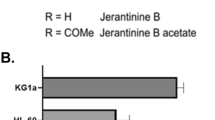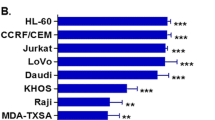Summary
Quaternary benzo[c]phenanthridines such as fagaronine are natural substances which have been reported to exhibit anticancer and anti-leukemic properties. However, the therapeutic use of these molecules is limited due to the high dose required to exhibit anti-tumor activity and subsequent toxicity. In this study, we describe the therapeutic potential of a new derivative of fagaronine, Ethoxyfagaronine (N-methyl-12-ethoxy-2hydroxy-3, 8, 9-trimethoxybenzo[c]-phenanthridiniumchlorhydrate) as an anti-leukemic agent. Cytotoxic activity and cell growth inhibition of Ethoxyfagaronine (Etxfag) was tested on murine L1210 leukemia cells using trypan blue assay and MTT assay. At the concentration of 10−7 M, Etxfag induced less than 10% of cell death. Etxfag (10−7 M) was tested on L1210 cell invasiveness using matrigel™ precoated transwell chambers and efficiently reduces the invasive potential of L1210 cells by more than 50% as compared with untreated cells. Western blot and immunofluorescence experiments showed that Etxfag decreased both MT1-MMP expression and activation at the cell surface, decreased plasmin activity by down-regulating u-PAR and uPA expression at the cell surface and increasing PAI-1 secretion in conditioned media. The set of our findings underscore the therapeutic potential of ethoxyfagaronine as a new potential anticancer agent able to prevent leukemic cell dissemination.






Similar content being viewed by others
References
Pui CH, Jeha S (2007) New therapeutic strategies for the treatment of acute lymphoblastic leukaemia. Nat Rev Drug Discov 6:149–165
Ries C, Loher F, Zang C, Ismair MG, Petrides PE (1999) Matrix metalloproteinase production by bone marrow mononuclear cells from normal individuals and patients with acute and chronic myeloid leukemia or myelodysplastic syndromes. Clin Cancer Res 5:1115–1124
Lynch CC, McDonnell S (2000) The role of matrilysin (MMP-7) in leukaemia cell invasion. Clin Exp Metastasis 18:401–406
Devy L, Hollender P, Munaut C, Colige A, Garnotel R, Foidart JM, Noel A, Jeannesson P (2002) Matrix and serine protease expression during leukemic cell differentiation induced by aclacinomycin and all-trans-retinoic acid. Biochem Pharmacol 63:179–189
Stefanidakis M, Koivunen E (2006) Cell-surface association between matrix metalloproteinases and integrins: role of the complexes in leukocyte migration and cancer progression. Blood 108:1441–1450
Murphy G, Stanton H, Cowell S, Butler G, Knauper V, Atkinson S, Gavrilovic J (1999) Mechanisms for pro matrix metalloproteinase activation. APMIS 107:38–44
Reikvam H, Hatfield KJ, Oyan AM, Kalland KH, Kittang AO and Bruserud O (2009) Primary human acute myelogenous leukemia cells release matrix metalloproteases and their inhibitors: release profile and pharmacological modulation. Eur J Haematol
Paupert J, Mansat-De Mas V, Demur C, Salles B, Muller C (2008) Cell-surface MMP-9 regulates the invasive capacity of leukemia blast cells with monocytic features. Cell Cycle 7:1047–1053
Suminoe A, Matsuzaki A, Hattori H, Koga Y, Ishii E, Hara T (2007) Expression of matrix metalloproteinase (MMP) and tissue inhibitor of MMP (TIMP) genes in blasts of infant acute lymphoblastic leukemia with organ involvement. Leuk Res 31:1437–1440
Dano K, Romer J, Nielsen BS, Bjorn S, Pyke C, Rygaard J, Lund LR (1999) Cancer invasion and tissue remodeling–cooperation of protease systems and cell types. APMIS 107:120–127
Rosmann S, Hahn D, Lottaz D, Kruse MN, Stocker W, Sterchi EE (2002) Activation of human meprin-alpha in a cell culture model of colorectal cancer is triggered by the plasminogen-activating system. J Biol Chem 277:40650–40658
Plow EF, Herren T, Redlitz A, Miles LA, Hoover-Plow JL (1995) The cell biology of the plasminogen system. FASEB J 9:939–945
Bene MC, Castoldi G, Knapp W, Rigolin GM, Escribano L, Lemez P, Ludwig WD, Matutes E, Orfao A, Lanza F, Van’t Veer M (2004) CD87 (urokinase-type plasminogen activator receptor), function and pathology in hematological disorders: a review. Leukemia 18:394–400
Narla RK, Dong Y, Klis D, Uckun FM (2001) Bis(4, 7-dimethyl-1, 10-phenanthroline) sulfatooxovanadium(I.V.) as a novel antileukemic agent with matrix metalloproteinase inhibitory activity. Clin Cancer Res 7:1094–1101
Philchenkov A, Kaminskyy V, Zavelevich M, Stoika R (2008) Apoptogenic activity of two benzophenanthridine alkaloids from Chelidonium majus L. does not correlate with their DNA damaging effects. Toxicol In Vitro 22:287–295
Nakanishi T, Suzuki M, Saimoto A, Kabasawa T (1999) Structural considerations of NK109, an antitumor benzo[c]phenanthridine alkaloid. J Nat Prod 62:864–867
Messmer WM, Tin-Wa M, Fong HH, Bevelle C, Farnsworth NR, Abraham DJ, Trojanek J (1972) Fagaronine, a new tumor inhibitor isolated from Fagara zanthoxyloides Lam. (Rutaceae). J Pharm Sci 61:1858–1859
Comoe L, Jeannesson P, Trentesaux C, Desoize B, Jardillier JC (1987) The antileukemic alkaloid fagaronine and the human K 562 leukemic cells: effects on growth and induction of erythroid differentiation. Leuk Res 11:445–451
Stermitz FR, Larson KA, Kim DK (1973) Some structural relationships among cytotoxic and antitumor benzophenanthridine alkaloid derivatives. J Med Chem 16:939–940
Lynch MA, Duval O, Sukhanova A, Devy J, MacKay SP, Waigh RD, Nabiev I (2001) Synthesis, biological activity and comparative analysis of DNA binding affinities and human DNA topoisomerase I inhibitory activities of novel 12-alkoxy-benzo[c]phenanthridinium salts. Bioorg Med Chem Lett 11:2643–2646
Deroussent A, Re M, Hoellinger H, Vanquelef E, Duval O, Sonnier M, Cresteil T (2004) In vitro metabolism of ethoxidine by human CYP1A1 and rat microsomes: identification of metabolites by high-performance liquid chromatography combined with electrospray tandem mass spectrometry and accurate mass measurements by time-of-flight mass spectrometry. Rapid Commun Mass Spectrom 18:474–482
Mosmann T (1983) Rapid colorimetric assay for cellular growth and survival: application to proliferation and cytotoxicity assays. J Immunol Methods 65:55–63
Friberger P, Knos M, Gustavsson S, Aurell L, Claeson G (1978) Methods for determination of plasmin, antiplasmin and plasminogen by means of substrate S-2251. Haemostasis 7:138–145
Agren MS, Mirastschijski U, Karlsmark T, Saarialho-Kere UK (2001) Topical synthetic inhibitor of matrix metalloproteinases delays epidermal regeneration of human wounds. Exp Dermatol 10:337–348
Klein G, Vellenga E, Fraaije MW, Kamps WA, de Bont ES (2004) The possible role of matrix metalloproteinase (MMP)-2 and MMP-9 in cancer, e.g. acute leukemia. Crit Rev Oncol Hematol 50:87–100
Polette M, Birembaut P (1998) Membrane-type metalloproteinases in tumor invasion. Int J Biochem Cell Biol 30:1195–1202
Itoh Y (2006) MT1-MMP: a key regulator of cell migration in tissue. IUBMB Life 58:589–596
Andreasen PA, Egelund R, Petersen HH (2000) The plasminogen activation system in tumor growth, invasion, and metastasis. Cell Mol Life Sci 57:25–40
Sun X, Li Y, Yu W, Wang B, Tao Y, Dai Z (2008) MT1-MMP as a downstream target of BCR-ABL/ABL interactor 1 signaling: polarized distribution and involvement in BCR-ABL-stimulated leukemic cell migration. Leukemia 22:1053–1056
Maruyama T, Yamamoto S, Nojima M, Morita N, Tanizawa T, Shima H (2007) Extramedullary relapse of acute lymphoblastic leukemia in childhood to the prostate. Int J Urol 14:447–449
Larsen AK, Grondard L, Couprie J, Desoize B, Comoe L, Jardillier JC, Riou JF (1993) The antileukemic alkaloid fagaronine is an inhibitor of DNA topoisomerases I and II. Biochem Pharmacol 46:1403–1412
Vanquelef E, Helesbeux JJ, Duval O, Debiton E, Barthomeuf C, Jarry C, Forfar I, Richomme P (2007) Synthesis and PC3 androgen-independent prostate cells antiproliferative effect of fagaronine derivatives. J Enzyme Inhib Med Chem 22:647–654
Geran RI, Greenberg NH, Macdonald MM and Abbott BJ (1977) Modified protocol for the testing of new synthetics in the L1210 lymphoid leukemia murine model in the DR&D program, DCT, NCI. Natl Cancer Inst Monogr 151–3
Li S, Chen ZX, Wang W, Cen JN, Fu JX, Yao L (2003) The expression and clinical implication of gelatinase A in acute leukemic cells. Zhonghua Nei Ke Za Zhi 42:684–687
Szabova L, Chrysovergis K, Yamada SS, Holmbeck K (2008) MT1-MMP is required for efficient tumor dissemination in experimental metastatic disease. Oncogene 27:3274–3281
Yu W, Sun X, Clough N, Cobos E, Tao Y, Dai Z (2008) Abi1 gene silencing by short hairpin RNA impairs Bcr-Abl-induced cell adhesion and migration in vitro and leukemogenesis in vivo. Carcinogenesis 29:1717–1724
Gu BJ, Wiley JS (2006) Rapid ATP-induced release of matrix metalloproteinase 9 is mediated by the P2X7 receptor. Blood 107:4946–4953
Wei W, Ryu JK, Choi HB, McLarnon JG (2008) Expression and function of the P2X[7] receptor in rat C6 glioma cells. Cancer Lett 260:79–87
Shemon AN, Sluyter R, Conigrave AD, Wiley JS (2004) Chelerythrine and other benzophenanthridine alkaloids block the human P2X7 receptor. Br J Pharmacol 142:1015–1019
Lanza F, Castoldi GL, Castagnari B, Todd RF 3 rd, Moretti S, Spisani S, Latorraca A, Focarile E, Roberti MG, Traniello S (1998) Expression and functional role of urokinase-type plasminogen activator receptor in normal and acute leukaemic cells. Br J Haematol 103:110–123
Mustjoki S, Alitalo R, Stephens RW, Vaheri A (1999) Plasminogen activation in human leukemia and in normal hematopoietic cells. APMIS 107:144–149
Acknowledgements
I would like to thank Dr H. Kaplan for his help with Analyze and Amira. I would like also to thank Dr L. Devy for her advices.
Author information
Authors and Affiliations
Corresponding author
Additional information
This work was supported by grants from the Centre National de la Recherche Scientifique (UMR 6237), the University of Reims Champagne Ardenne, the Region Champagne Ardenne, the Ligue Nationale Contre le Cancer (Comité de la Haute-Marne). The confocal microscope observations were performed at INRA, UMR FARE, Reims.
Jérôme Devy and Farid Ouchani have equally contributed to the work.
Rights and permissions
About this article
Cite this article
Devy, J., Ouchani, F., Oudot, C. et al. The anti-invasive activity of synthetic alkaloid ethoxyfagaronine on L1210 leukemia cells is mediated by down-regulation of plasminogen activators and MT1-MMP expression and activity. Invest New Drugs 29, 730–741 (2011). https://doi.org/10.1007/s10637-010-9410-x
Received:
Accepted:
Published:
Issue Date:
DOI: https://doi.org/10.1007/s10637-010-9410-x




